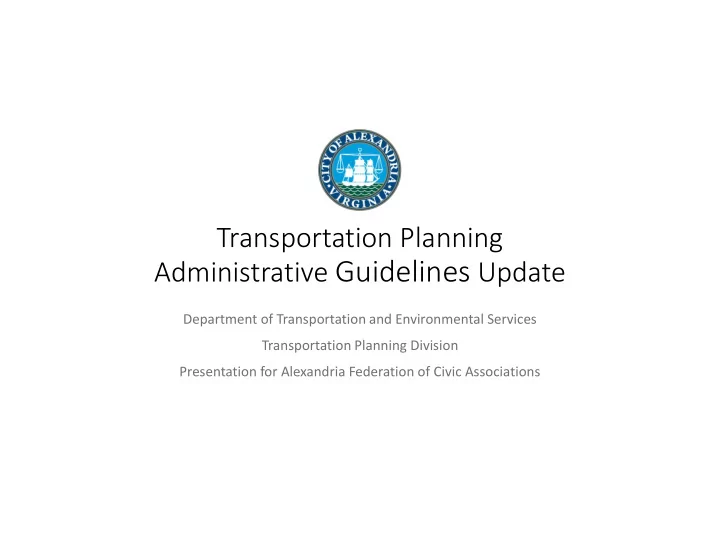

Transportation Planning Administrative Guidelines Update Department of Transportation and Environmental Services Transportation Planning Division Presentation for Alexandria Federation of Civic Associations
What are the different types of multimodal transportation studies? 1. Development Applications - Development Special Use Permits - Coordinated Development Districts 2. Small Area Plans - Larger “scope” plans that examine land use 3. City-Initiated Studies - City Projects (generally smaller scope) - Studies based on larger public process, as programmed in the City Capital Improvement Plan Overview What? Why? How? Q&A Current Update Process
What do multimodal transportation studies assess? • Existing transportation conditions : • Vehicular travel • Parking occupancy/capacity • Transit service and infrastructure • Pedestrian/bicycle facilities • Future transportation conditions: • With new development • Without new development Overview What? Why? How? Q&A Current Update Process
What do multimodal studies assess for non-drivers? Transit Service Transit Infrastructure Pedestrian Infrastructure Bicycle Infrastructure Image Source: NACTO Urban Street Design Guidelines Overview What? Why? How? Q&A Current Update Process
What do multimodal studies assess for dri rivers? Level of Service Delay Intersection Queuing On-Street Parking Occupancy Image Source: NACTO Urban Street Design Guidelines Overview What? Why? How? Q&A Current Update Process
Why are multimodal studies run for Development Applications? • Help Transportation and Environmental Services staff determine immediate impacts of development • If impacts detrimental, staff works with applicant to revise application or provide mitigations • If impacts are acceptable, staff works with the applicant to provide community benefits • In both cases, staff works to ensure mobility is acceptable per the City’s Transportation Master Plan Overview What? Why? How? Q&A Current Update Process
Why are multimodal studies run for Small Area Plans? • Provides macro-level analysis of what a larger area can “hold” without impacting existing residents / businesses • Inventory pedestrian/bicycle/transit improvements for future development mitigations & City projects • Help guide staff in review of future development applications Overview What? Why? How? Q&A Current Update Process
Why are multimodal studies initiated by staff? • Assess, reassess, and/or support planned capital improvements • Sometimes triggered by citizen request , as with the Central City Traffic Study • Transportation studies proposed through a public process must be funded through the City’s CIP Overview What? Why? How? Q&A Current Update Process
How does the City use the information? • For development applications , staff determine if mitigations are necessary • Mitigations must be linked to development impacts to protect against potential litigation • Mitigations include (but are not limited to): • New signals / signal timing adjustments • Pedestrian / bicycle / transit facilities upgrades • Transportation Demand Management plans and contributions Overview What? Why? How? Q&A Current Update Process
How does the City use the information? • For small area plans , staff determine if capital improvements are necessary • Phasing and triggers noted in Plan or its associated appendices to inform development community • For City-initiated projects , staff determine if capital improvements, signal adjustments, speed adjustments, etc. are necessary. Overview What? Why? How? Q&A Current Update Process
How do studies help the City see the big picture? • All studies account for “background development” • All studies assume regional growth in trips, originating both within and beyond Alexandria • City uses Washington Council of Governments data to inform growth assumptions • Each study presents the most accurate picture of future conditions based on best assumptions Overview What? Why? How? Q&A Current Update Process
Proposed Revisions to Existing Transportation Guidelines • Additional time for City staff review based on context • Additional parking study requirement for small projects • New requirement to use software selection tool (consistent with VDOT requirements) • New policy statement on mitigations that supports Alexandria’s Multimodal Vision • Flexibility to coordinate study requirements with small area plan updates Overview What? Why? How? Q&A Current Update Process
Questions? patrick.reed@alexandriava.gov 703.746.4147 Overview What? Why? How? Q&A Current Update Process
Recommend
More recommend